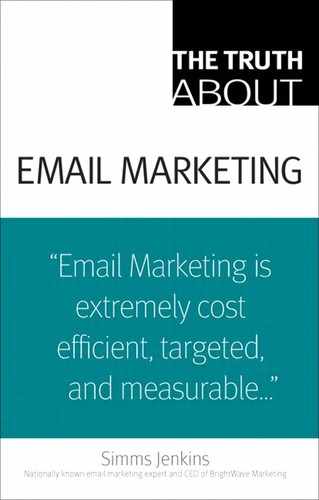Truth 10. Getting the ball rolling with your email marketing partner
After selecting a partner to help move your email program to a new level, you are faced with actually getting the ball rolling internally and making sure the firm you selected is moving you toward achieving your goals. As I mentioned in the last truth, I'm going to focus on the example of working with a firm to help evaluate, create, and implement strategy, although these steps apply to working with any type of outside email expert on any type of engagement (whether it be long-term- or project-based).
The truth hurts
Remember that you may—and should—receive some information that does not paint your email program as high achieving as you had thought. Be prepared to receive some tough love and accept much constructive criticism. If your new strategy partner doesn't offer that or your team is not in a position to handle it, your money would be better spent elsewhere.
Know where your money is going
At the onset of the engagement, both parties should be very clear on what deliverables will be due, as well as a timeline for any and all projects. Email strategy projects vary in time, usually based on scope and availability of client resources (for investigative interviews and document coordination). Email strategy projects generally shouldn't run more than three months, unless the scope of deliverables and email program components audited are extensive.
Pricing is usually based on an agreed-upon hourly rate, a monthly retainer, or a fixed fee based on the projected time and deliverables agreed upon in advance by both parties.
Execution
After your statement of work is signed, your new partner should not disappear, only to resurface with a large document months later. Part of the client's responsibility is providing access to key staff and data that will help shed light on how this email program is performing. A weekly team status call or report can help ensure that there are no surprises. The client will have to manage the project, no matter how good your partner is, and you must face this reality to maximize the results and learnings from the engagement.
Educate and sell internally
A crucial aspect of an email strategy engagement is internal buy-in. Your program could suffer a blow if you don't properly explain to all relevant parties why a third party will be examining inner email workings. Be sure to tell key stakeholders that this is not a reflection of any disappointment with the team or admittance of failure on anyone's part, but only a neutral evaluation on ways to improve. You need to get their buy-in to ensure that the findings will be embraced or successfully implemented. Don't forget to include other stakeholders that may not be intimately involved in your daily email efforts, such as your IT or sales department.
Making sense of it all
After determining strategy, be sure to have the firm come in and present it to all individuals and teams that use email in any capacity. This ensures that everyone is on board and on the same page when it comes to implementing suggestions and changes. Having at least a few senior management executives at the meeting will help reaffirm your company's commitment to email marketing. This should not be a one-way presentation, so encourage participation. Be sure to come prepared and ask questions on every front.
Follow-up
Your company would be best served having the email strategy partner retained, at least on a minor basis, for a few months after the initial project is completed. While most email consulting and services firms should help articulate or clarify any of the information they assembled after projection completion, the client will often find that a deeper follow-up is needed. For example, if part of the project had actionable items on how to improve your open rates, you may want to keep the firm on retainer to help implement tests and ensure that its findings are accurately put into practice.
Also, be prepared to repeat the process at a later date. Business needs change, as does the email marketing landscape. So it's important to review recommendations at regular intervals to ensure, for example, that practices are up to date and reflect new realities.
Get to work
Don't let a 100-page strategy document end up in a file that collects only dust. You paid good money for someone to dig deep into your email program and, better yet, you'll be held accountable for making sure it gets put into practice. Even if the document uncovers some flaws, get to work and use that information to make your email program even better.
Lynn Moss is an interactive marketing veteran currently at Definition 6, with experience on both the agency and client side. She offered up these closing tips for managing an email strategy project:
“As a client, be prepared to share information about how email addresses are captured, what is stored on each customer or prospect, metrics on all your email campaigns, as well as offline marketing efforts. The email strategy vendor may suggest a new look and feel, new language, or more ways to target users. Continue to test recommended changes in order to optimize email campaigns.
As a consultant, it can be difficult to convince senior management that the email marketing strategy should be given as much thought as the marketing strategy. There should be dedicated resources, and the strategy needs to continue to evolve.”
